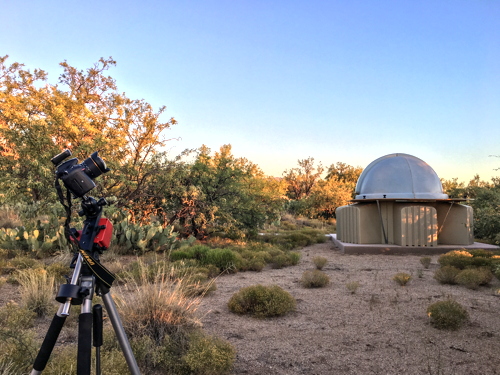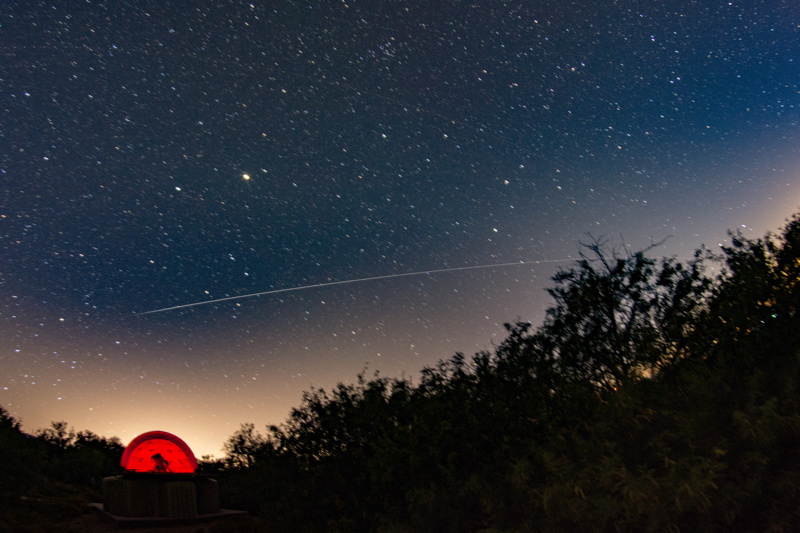SkyTracker Pro ISS;
Messier Globular Star Clusters, Jupiter, Saturn, 61 Cygni
Posted: 14 June 2017
Sunday, 11 June 2017, was clear but had strong (Red Flag Warning) winds. Missed imaging an excellent pass of the International Space Station due to the strong winds. Similar conditions occurred on Monday, 12 June, and I missed another ISS pass. Tuesday, 13 June, was clear with breezes in the afternoon.
|
Open: Tuesday, 13 June 2017, 1901 MST Temperature: 94°F |
Session: 1122 Conditions: Clear |
Equipment Used:
12" f/8 LX600 w/StarLock
2" 24mm UWA eyepiece
1.25" 15mm eyepiece
1.25" 3 TeleNegative
2" 2X PowerMate
SkyTracker Pro
Camera:
D7200 DSLR
1909 MST: LX600 ON, StarLock OFF, High Precision OFF.
1912 MST: viewed Jupiter, 102X. Three moons visible. Switched to 488X and viewed Jupiter. View wasn't good as sky was still too bright.
1915 MST: began setting up the SkyTracker Pro for this night's pass of the International Space Station (ISS). Would use the D7200 DSLR with a 8mm fisheye lens:

1927 MST: returned to the observatory. 1936 MST: sunset. Viewed Jupiter, 488X. Four moons and the Great Red Spot were visible.
Mounted the D7200 DSLR at prime focus + 3X TeleNegative, focused on Jupiter. Did some HD video recordings of the planet. This is a stack of 642 video frames (10 seconds), 1.3X crop factor, 60 fps, 1/125sec, ISO 1600, FL 8mm fisheye lens, White Balance Auto:

The Great Red Spot is visible at the lower right.
1948 MST: finished Jupiter imaging. Removed the camera and viewed Jupiter, 163X. Nice view. 2028 MST: final look at Jupiter.
Viewed M13 (Great Globular Cluster in Hercules), 163X.
2045 MST: began preparing for the ISS pass. Polar aligned the SkyTracker Pro, set the tracking rate to 1/2X Sidereal. This is a 4m 10s exposure, f/5, ISO 1600, White Balance 3570K:

2110 MST: returned to the observatory. Mounted the DLSR at prime focus of the 12" telescope, focused on the star Vega, and locked the primary mirror. 2119 MST: StarLock ON. This is a StarLock autoguided, 30 seconds, ISO 1600, WB 3570K image of M13 (globular cluster):

This is M56 (globular cluster), StarLock autoguided, 30 seconds, ISO 3200, WB 3570K:

And M14 (globular cluster), StarLock autoguided, 30 seconds, ISO 3200, WB 3570K:

2204 MST: StarLock OFF. Slewed to the star Deneb, added the 2X PowerMate, focused, locked the mirror, and SYNCed the AutoStar.
2220 MST: Wi-Fi ON. Used SkySafari 5 Pro on the iPhone 6s Plus to GOTO the double star 61 Cygni. This is a 10 seconds, ISO 1600, WB 3570K image:

I had previously imaged 61 Cygni in July 2014 and again in July 2015 using the 8" LX200-ACF telescope. This image shows the double star proper motion in 12 months:

I plan to image 61 Cygni again in 3 months to see if I can show the proper motion in that short a period of time.
2227 MST: Wi-Fi OFF.
Removed the PowerMate and added the 3X TeleNegative. Slewed to the planet Saturn. Did some HD video recordings at prime focus + 3X TeleNegative. This is a stack of 915 video frames (30 seconds), 1.3X crop factor, 60 fps, 1/60sec, ISO 1600, White Balance Auto:

2250 MST: ended imaging. The eastern sky was brightening from the rising waning gibbous Moon. Viewed Saturn, 488X, 163X, and 102X. The seeing was not good so the view at 488X was not very good, although Cassini Division and some cloud bands were visible.
2307 MST: LX600 OFF. Terminated a Kissing Bug inside the observatory.
|
Close: Tuesday, 13 June 2017, 2334 MST Temperature: 67°F |
Session Length: 4h 33m Conditions: Clear, breezy |
Comments are welcome using Email. Twitter users can use the button below to tweet this report to your followers. Thanks.
Cassiopeia Observatory Home Page
Copyright ©2017 Michael L. Weasner / mweasner@me.com
URL = http://www.weasner.com/co/Reports/2017/06/14/index.html
